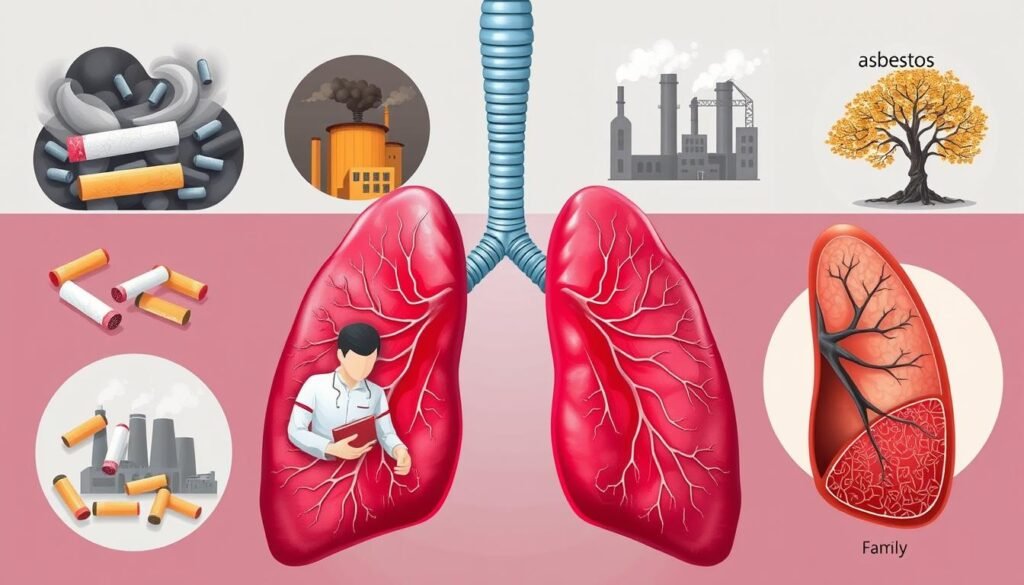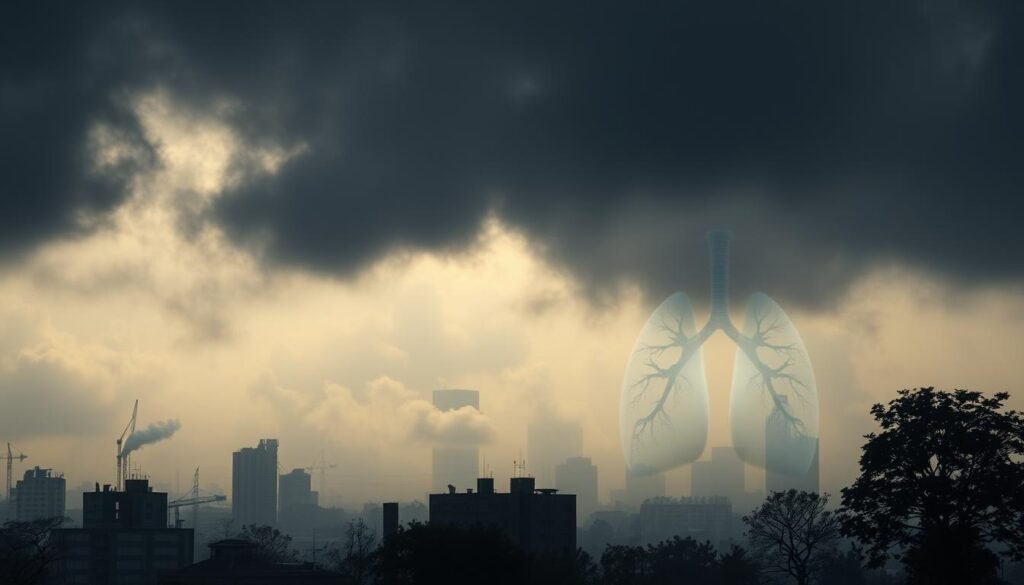Every two minutes, someone in the United States learns they have lung cancer. This fact shows how widespread lung cancer is, affecting countless lives. More than 361 people die from it each day. It’s essential to know about lung cancer’s average risk, what causes it, and the latest in finding it early.
Recent stats on lung cancer underline the importance of being aware and taking steps to prevent it. Knowing what affects your risk can lead to better outcomes. Let’s explore the factors that play a role in lung cancer and how early detection is changing the game.
Key Takeaways
- Lung cancer is diagnosed approximately every two minutes in the US.
- More than 361 individuals die from lung cancer each day.
- Only 16.0% of eligible individuals were screened for lung cancer in 2022.
- The survival rate for lung cancer has improved by 26% over the past five years.
- Lung cancer screening could save 500,000 additional years of life if all eligible individuals were screened.
- Rhode Island leads in lung cancer screening rates with 28.6%.
What is Lung Cancer?
Lung cancer is a serious type of cancer that starts in the lungs. It is mainly divided into two types: small cell lung cancer (SCLC) and non-small cell lung cancer (NSCLC). About 80% to 85% of lung cancers are non-small cell, while small cell makes up 10% to 15%.
Most people who get lung cancer are older adults, usually around 70 years old. Lung cancer is the top cause of cancer deaths in the U.S. It kills more people than colon, breast, and prostate cancers combined. Knowing about the different types of lung cancer helps us understand its risks and the impact on public health.
Lung cancer poses a big health challenge. Being aware of its types and features is vital for people diagnosed with it. This understanding can lead to better health outcomes.
Current Lung Cancer Statistics
Lung cancer is a major health issue in the United States. The numbers are worrying. About 209,500 people were diagnosed with it in 2021. Experts think that by 2024, this number will go up to 234,580 current lung cancer cases. More men get and die from lung cancer than women.
Lung cancer deaths are shockingly high. In 2022, 131,888 people died from it. This made up 20.4% of all cancer deaths. It’s the top cause of cancer death. About half of the people find out they have lung cancer when it’s spread. Only about 25% catch it early when it’s still just in the lungs.
The survival rates for lung cancer are low, just 28% over five years. It depends a lot on how soon it’s found. If caught early, the survival rate can be about 63.7%. This shows how vital it is to find and treat lung cancer early on.
The global situation is also serious, with 2,480,675 cases worldwide in 2022. China has a very high number of cases. The United States is still trying hard to fight this disease.
| Year | New Cases | Deaths | 5-Year Survival Rate |
|---|---|---|---|
| 2021 | 209,500 | 131,888 | 28% |
| 2024 (Estimated) | 234,580 | 125,070 | 26.7% |
Average Risk of Lung Cancer
The risk of lung cancer varies among people due to different factors. Knowing this risk helps us make better health choices. Men face a lifetime risk of 1 in 16, while for women, it’s 1 in 17. These numbers consider both smokers and non-smokers. This shows lung cancer affects both groups.
Lifetime Risk for Men and Women
The chance of getting lung cancer has changed over time. For Swiss men, the risk dropped from 7.1% to 6.7% between 1995 and 2013. This drop suggests progress in public health efforts and quitting smoking. For women, their risk went up from 2.5% to 4.1% in the same span. These stats show how lung cancer rates differ by gender and lifestyle choices.
Influence of Smoking on Risk
Smoking hugely raises the risk of lung cancer. Smokers are 15 to 30 times more likely to get lung cancer than non-smokers. Even those who smoke occasionally face a higher risk. Around 80% of lung cancer deaths are linked to smoking. It’s clear how vital prevention and education on smoking and lung cancer are.
Key Risk Factors for Lung Cancer
Lung cancer’s risk comes from many sources, some of which we can control. Knowing these key risk factors can greatly help in prevention.
Cigarette Smoking
Cigarette smoking is the top risk factor for lung cancer. It is linked to about 90 percent of cases. The more you smoke and the longer you do, the higher your risk. Stopping smoking could prevent most lung cancer cases.
Secondhand Smoke Exposure
Being around smoke when you don’t smoke is also risky. Non-smokers living with smokers have a higher lung cancer risk. This kind of exposure leads to many lung cancer deaths in non-smokers.
Radon Exposure
Radon in poorly ventilated homes is a big risk too. It’s blamed for about 30 percent of lung cancer deaths in non-smokers. Checking your home for radon is an important step.
Occupational Carcinogens
Workplace exposures, like asbestos and diesel exhaust, can raise your lung cancer risk. This is especially true for smokers. Asbestos is linked to most mesothelioma cases.
Family History of Lung Cancer
Having lung cancer in your family doubles your own risk. If you have two or more relatives with lung cancer, your risk is even higher.

For more information, visit the American Cancer Society. Awareness and taking preventive measures can decrease lung cancer rates.
Age and Lung Cancer Risk
Age is a big factor in lung cancer risk. It’s important to know how age relates to lung cancer. This is crucial since most people who get diagnosed are older. A lot of lung cancer cases are found in those 65 and older. This makes it an important area to study.
The Importance of Age as a Factor
There’s a strong link between age and lung cancer. Lung cancer becomes more common as people get older. The average age for finding lung cancer is about 70 years old. This shows why age is key in understanding risk.
People who are 75 and older have the highest rates of lung cancer. Over half of the cases are in people from 55 to 74. Moreover, older adults have a shorter survival time. This shows how crucial age is in lung cancer’s risk and outcome.
Typical Age of Diagnosis
The usual age for a lung cancer diagnosis shows the risks of getting older. Very few cases are in people under 45. This means lung cancer is mostly in older groups.
The CDC shows a trend that is worrying. The highest number of new cases is in those 75 to 79. This highlights the need to focus on prevention and screenings for older people. They are at the highest risk.
Impact of Air Pollution on Lung Cancer
Air pollution significantly raises the risk of lung cancer. Studies have shown that long-lasting exposure to dirty air worsens lung conditions and may lead to cancer. Pollutants like PM2.5 are mainly to blame. A study involving over 12 million people found 166,860 lung cancer cases, linking air pollution directly to the disease.
PM2.5 increases lung cancer deaths alarmingly. Just a tiny rise in PM2.5 levels can make lung cancer more likely. In 2019, about 15% of lung cancer deaths worldwide were due to PM2.5. NO2 also poses a similar risk, showing the ties between air pollution and lung cancer.
Air pollution’s effect on lung cancer cannot be ignored. The International Agency for Research on Cancer labels it as a top-level carcinogen. Confirming studies highlight the deadly link between PM2.5 and lung cancer. It’s vital to grasp how air purity affects our health.

Knowing the dangers air pollution poses to lung cancer is key. It calls for ongoing research and effective public health measures. It’s about making the air cleaner for the good of all. Resources on air pollution effects and environmental factors offer more on lung cancer and pollution.
| Pollutant Type | Health Effects | Associated Hazard Ratio |
|---|---|---|
| PM2.5 | Increases lung cancer risk | 1.008 per 1 μg/m³ |
| NO2 | Increases lung cancer mortality | 1.013 per 1 ppb |
| Ozone (O3) | Linked to lung cancer risk | Varied across studies |
| Particle Radioactivity (PR) | Potential increase in lung cancer incidence | 1.005 per 1-mBq/m³ |
Reducing air pollution is vital for lowering lung cancer risk. It’s all about cutting down harmful pollutants and promoting better air. Educating people on these risks can save lives.
Early Detection Methods for Lung Cancer
Finding lung cancer early improves outcomes for those diagnosed. Screening on time boosts the odds of finding the disease when it’s easier to treat. It’s crucial for people with a history of heavy smoking to know about lung cancer screening. Low-dose computed tomography (LDCT) is a popular way to detect lung cancer early.
Lung Cancer Screening Guidelines
The American College of Chest Physicians (CHEST®) says people 55 to 77 who smoked a lot should get checked every year. They recommend this for those who’ve smoked 30 pack-years or have a 20 pack-year history and are 50 to 80 years old. The National Comprehensive Cancer Network® (NCCN®) agrees but adds those who quit in the last 15 years. Medicare might cover the screening costs if you meet the criteria. Following these guidelines can lower death rates and make life better for those at risk.
Advancements in Detection Techniques
New ways to spot lung cancer are getting better all the time. Low-dose CT scans are now 20% more effective than old x-rays. PET/CT scans also do a great job, catching nearly all the cancer with 98.7% accuracy. There’s buzz around liquid biopsies too. They check for cancer cells in your blood, which could catch cancer sooner.
Tools like narrow band imaging (NBI) and autofluorescence bronchoscopy (AFB) are making waves, too. They help find cancer early without needing invasive procedures. This boosts your chances of beating lung cancer.
Preventative Measures Against Lung Cancer
Taking steps to prevent lung cancer is key to lowering your risk. Being proactive can greatly decrease the likelihood of getting this disease. This is vital because many factors increase the risk of lung cancer.
Smoking Cessation Programs
Smoking is a top reason for lung cancer. It’s behind about 90% of cases in men and 80% in women. Joining smoking cessation programs helps people stop smoking. These efforts can cut lung cancer risk by 30% to 60% over ten years.
Such programs offer support and tools to make quitting easier and lasting.
Home Testing for Radon
Radon is a big risk for lung cancer. Testing for radon at home is crucial, especially in high-radon areas. If you find high radon levels, taking steps to fix it can cut your risk. This is extra important for smokers, as it may lower their lung cancer risk even more.
Reducing Exposure to Occupational Toxins
Some jobs can expose people to cancer-causing substances. Lowering exposure to toxins like asbestos and arsenic is important for safety. Jobs should have rules and training to help workers stay safe from these dangers. This can help reduce lung cancer cases.

Survival Rates and Prognosis
Knowing lung cancer survival rates is crucial for affected people and their families. These rates can differ greatly due to several factors. These include the cancer type, how early it’s found, and the patient’s health. It’s shown that finding the cancer early can boost survival chances.
Factors Affecting Lung Cancer Survival Rates
Some important factors impact lung cancer survival rates:
- Type of Lung Cancer: Non-small cell lung cancer (NSCLC) tends to have a more favorable outcome than small cell lung cancer (SCLC).
- Stage at Diagnosis: The earlier the cancer is found, the better the chances of survival.
- Patient’s Health: Factors like overall health, age, and how well treatments work play a role.
Statistics for Small Cell and Non-Small Cell Lung Cancer
The survival rates for small cell and non-small cell lung cancers show big differences:
| Lung Cancer Type | Localized Survival Rate | Regional Survival Rate | Distant Survival Rate | Overall Average Survival Rate |
|---|---|---|---|---|
| Non-small cell lung cancer (NSCLC) | 60% | 33% | 6% | 23% |
| Small cell lung cancer (SCLC) | 29% | 15% | 3% | 6% |
The SEER database shows five-year relative survival rates for lung cancer. Localized NSCLC survivors have a 65% chance, but this falls to 9% for distant NSCLC. SCLC has similar patterns, with a 30% chance if localized, dropping to 3% for distant stages. For more detailed information, visit this site.
Conclusion
Knowing the average risk of lung cancer is key to creating good prevention plans. It helps find the disease early. Lung cancer is the top reason for cancer deaths in the U.S. Each year, it takes as many lives as prostate, breast, and colon cancers together. Understanding risk factors like smoking, age, and the environment lets people choose better lifestyles. This can greatly reduce their chance of getting this deadly disease.
Prevention strategies are critical. They include programs to stop smoking and tests for radon at home. Screening programs are also important for spotting the disease early. This matters a lot because only about 15.6% of people live five years after they find out they have lung cancer. Teaching people about the dangers of lung cancer and how to live healthier is important. It encourages them to visit their doctors regularly.
Making an effort to understand lung cancer risks and taking action can save lives. It also can decrease how much this tough sickness affects people. If we keep focusing on education, research, and finding lung cancer early, we can make a better future. A future with less lung cancer is possible through ongoing work in these areas.